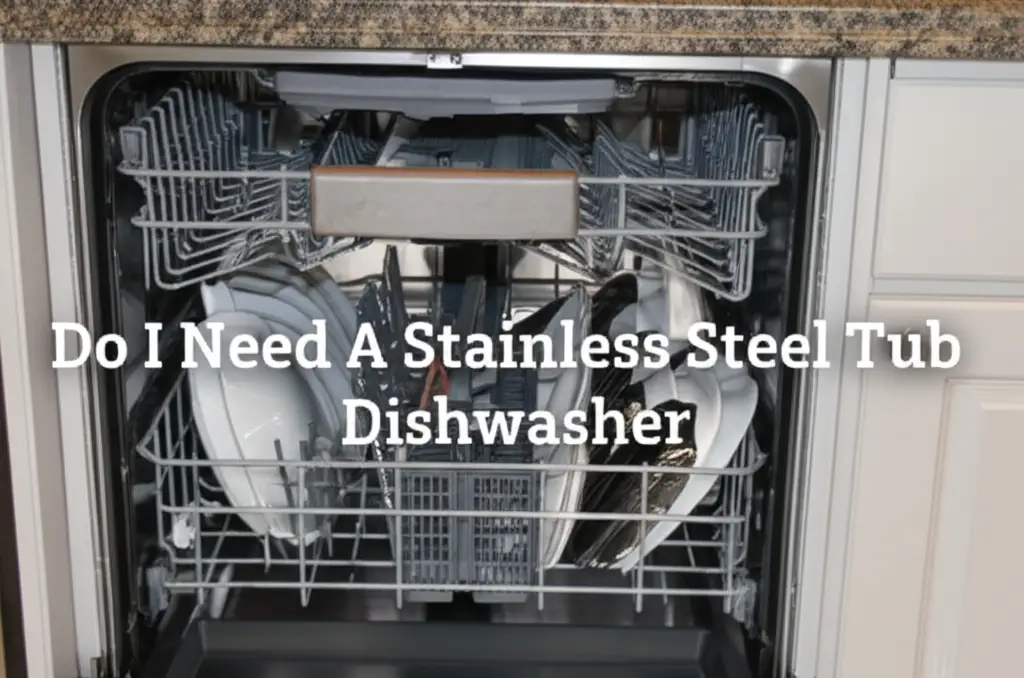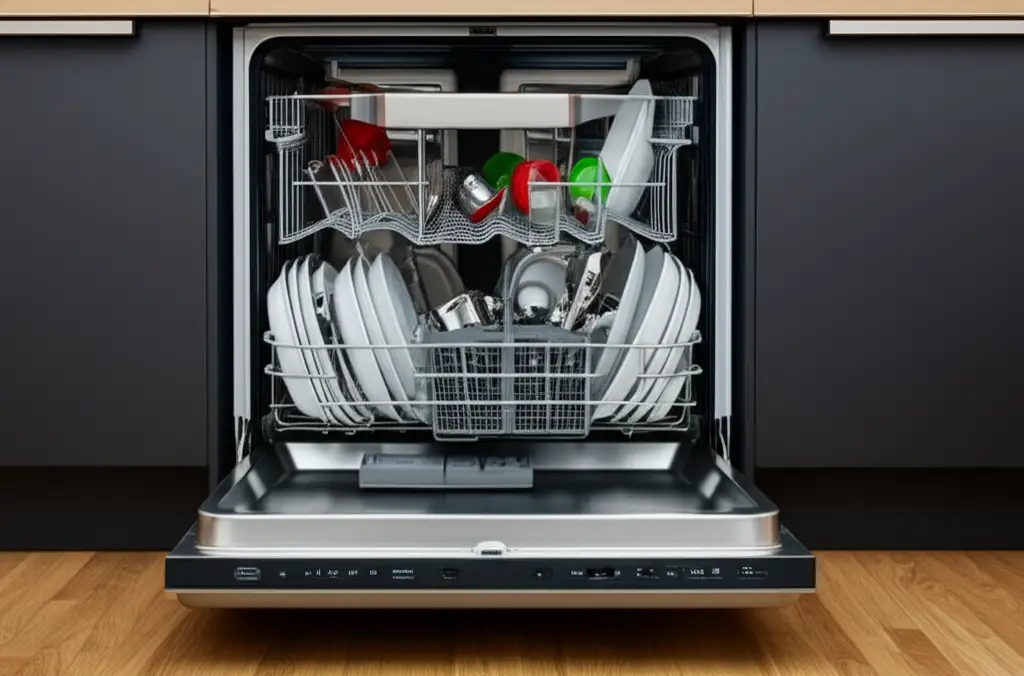· Elira Thomsen · Kitchen Appliances · 19 min read
Do I Need A Stainless Steel Tub Dishwasher

Stainless Steel Dishwasher Tub: Is It Right for You?
Deciding on a new dishwasher can feel like a big task. You want a machine that cleans well, lasts long, and fits your home’s needs. One common question often comes up: “Do I need a stainless steel tub dishwasher?” It’s a valid question. The material of your dishwasher tub affects its performance, durability, and even how quiet it runs.
This article will help you understand the differences between tub materials. We will look at the clear benefits of stainless steel. We will also talk about any drawbacks. We compare it with plastic and hybrid options. By the end, you will have a clear idea. You can decide if a stainless steel tub dishwasher is the best fit for your kitchen and lifestyle. Let’s explore the key features and considerations together.
Takeaway
- Stainless steel tubs offer superior durability and heat retention for better drying.
- They provide better noise insulation, making your kitchen quieter.
- Initial cost is higher, but the long-term value and hygiene benefits are significant.
- Consider your budget, usage frequency, and desire for quiet operation when deciding.
You might consider a stainless steel tub dishwasher if you value durability, quiet operation, and superior drying performance. It is a good choice for busy households seeking a long-lasting, hygienic appliance. However, it comes with a higher upfront cost compared to plastic tubs.
Understanding Dishwasher Tub Materials: Plastic Versus Stainless Steel
When you look for a new dishwasher, the tub material is a key difference. Most dishwashers have tubs made from either plastic or stainless steel. Each material offers distinct advantages and disadvantages. Knowing these helps you make an informed decision.
Plastic tubs are common in more budget-friendly dishwasher models. They are less expensive to produce. This makes the overall appliance more affordable. Plastic tubs are lighter in weight. They also resist dents and scratches quite well. However, plastic can absorb food odors over time. This might lead to a less fresh smell inside the dishwasher. Plastic tubs do not retain heat as well as stainless steel. This can affect drying performance. Often, plastic tub dishwashers use a heating element to dry dishes. This can use more energy. It also poses a small risk of melting plastics if not loaded correctly.
Stainless steel tubs are a feature of higher-end dishwashers. They are known for their strength and longevity. Stainless steel does not absorb odors. This keeps your dishwasher smelling clean cycle after cycle. Its smooth surface also resists stains and rust very well. Unlike plastic, stainless steel retains heat effectively. This helps with condensation drying, which is more energy-efficient. Stainless steel also helps muffle operating sounds. This makes the dishwasher quieter during cycles. The main drawback is the higher cost. This material makes the initial purchase more expensive. But many people find the benefits worth the extra investment.
Choosing between plastic and stainless steel tubs depends on your budget and priorities. If cost is your top concern, a plastic tub might suit you. If you seek better performance, quiet operation, and a longer lifespan, stainless steel is likely a better fit. Consider how often you use your dishwasher. Think about what features matter most to you.
The Core Benefits of a Stainless Steel Dishwasher Tub
A stainless steel tub in a dishwasher offers many significant benefits. These advantages often justify the higher price point for many homeowners. Let’s look at why stainless steel is a popular choice for modern kitchens.
Enhanced Durability and Longevity
Stainless steel is incredibly tough. It resists chipping, cracking, and staining much better than plastic. A stainless steel tub can handle daily use for many years without showing significant wear. This means your dishwasher tub maintains its look and function longer. You get a lasting appliance that performs consistently. The strong material protects against accidental impacts. It also stands up to high temperatures. This durability translates into a longer lifespan for your dishwasher. Many people see a stainless steel tub as a long-term investment.
Superior Drying Performance
One of the most noticeable benefits of a stainless steel tub is its drying ability. Stainless steel retains heat very well. After the wash cycle, the tub walls stay hot. When cool rinse water hits the hot tub, condensation forms on the cooler dishes. This process helps water droplets run off the dishes. This leads to much drier dishes at the end of the cycle. This method is called condensation drying. It is more energy-efficient than using a dedicated heating element. It also eliminates the risk of melting plastic items. This superior drying means less hand-drying after the cycle. You get ready-to-use dishes straight from the machine. If you find your dishes are still wet, understanding how to get the dishwasher to drain properly can also impact drying efficiency.
Excellent Noise Reduction
Stainless steel is a dense material. This density helps absorb sound vibrations. A dishwasher with a stainless steel tub typically runs much quieter than one with a plastic tub. The steel acts as a sound barrier. It keeps the washing noise contained within the appliance. This is a huge advantage for open-concept homes or busy kitchens. A quiet dishwasher does not interrupt conversations or daily activities. You can run it any time of day or night without disturbance. The difference in noise level can be quite remarkable. This contributes greatly to a more pleasant home environment.
Improved Hygiene and Odor Resistance
Plastic is a porous material. It can absorb food particles and odors over time. This may lead to unpleasant smells inside your dishwasher. Stainless steel, on the other hand, is non-porous. It does not absorb food stains or odors. This means your dishwasher tub stays cleaner and fresher. It also resists the growth of mold and mildew more effectively. For example, if you ever face issues like how to clean mold off dishwasher, a stainless steel tub might reduce the likelihood of such problems forming in the first place due to its less porous nature. A hygienic tub ensures your dishes are truly clean after every wash. This contributes to better kitchen hygiene overall. Maintaining cleanliness is easier with stainless steel. This benefit is a major plus for many households.
Addressing the Downsides: Cost and Maintenance of Stainless Steel
While stainless steel dishwasher tubs offer many advantages, they also come with certain considerations. Understanding these potential drawbacks helps you make a balanced decision. It ensures you know what to expect.
Higher Initial Investment
The most immediate downside of a stainless steel tub dishwasher is its price. These models are generally more expensive than their plastic-tub counterparts. The cost difference can be significant, sometimes hundreds of dollars. This higher upfront cost is due to the material itself. Stainless steel is more costly to source and manufacture into complex shapes. The advanced features often found in stainless steel models also add to the price. Things like better drying systems or quieter operation cost more. If you have a strict budget, this higher initial investment might be a barrier. However, many people view this as a long-term investment. They consider the extended lifespan and superior performance.
Potential for Water Spots and Fingerprints
Stainless steel tubs are inside the dishwasher. So, fingerprints are not an issue on the tub itself. However, many dishwashers with stainless steel tubs also have stainless steel exteriors. These external surfaces can show fingerprints and water spots easily. This might require more frequent cleaning to maintain a pristine look. While not directly related to the tub’s performance, it is a common aesthetic concern. You might need special cleaners for stainless steel surfaces. These cleaners prevent streaks and maintain the shine. Proper maintenance ensures your appliance always looks its best. You may need to use a soft cloth for wiping.
Specific Cleaning Considerations
While stainless steel is hygienic, it still needs proper care. A stainless steel tub is not immune to hard water deposits or food residue. Over time, mineral buildup can occur. This might affect the dishwasher’s efficiency. You might need to use dishwasher cleaners or natural solutions like vinegar. Knowing where to put vinegar in dishwasher to clean can help keep your tub spotless. It is important to avoid abrasive cleaners or harsh scrubbing pads. These can scratch the stainless steel surface. Scratches can dull the finish and potentially harbor dirt. Regular cleaning prevents issues and keeps the tub shining. It also helps maintain its hygienic properties. Ensure you clean the filter regularly too. You can learn how often should you clean your dishwasher filter to keep your dishwasher running efficiently.
The increased cost is the primary concern for many. The maintenance of the exterior is a small trade-off for the internal benefits. Overall, the downsides are manageable. They are often outweighed by the significant advantages of stainless steel.
Hybrid Stainless Steel Tubs: A Middle Ground?
Sometimes, you might come across dishwashers with “hybrid” tubs. These tubs offer a compromise between full plastic and full stainless steel. Understanding what a hybrid tub entails can help you weigh your options. It may be the perfect solution for your needs.
What Is a Hybrid Stainless Steel Tub?
A hybrid stainless steel tub typically combines materials. It usually features a plastic bottom or base. The sides and door liner are made of stainless steel. This design aims to blend the benefits of both materials. The plastic base keeps manufacturing costs lower. This translates to a more affordable dishwasher. The stainless steel components bring some of the advantages of a full stainless steel tub. For example, the stainless steel door liner helps with noise reduction. It also contributes to better drying because the steel heats up. This design is an attempt to offer a good balance. You get some premium features without the full premium price. For a deeper understanding, you can read what is a hybrid stainless steel tub in a dishwasher.
Advantages of Hybrid Tubs
Hybrid tubs offer a few key benefits. First, they are generally less expensive than full stainless steel models. This makes them a more accessible option for many budgets. You get a taste of stainless steel benefits without the full cost. Second, the stainless steel parts provide some noise reduction. They are usually quieter than all-plastic tubs. Third, the stainless steel portion helps with drying. It often uses condensation drying to some extent. This improves dish dryness compared to pure plastic tubs. Hybrid tubs often come with good features. They can be a strong contender for mid-range appliance shoppers.
Disadvantages and Considerations
Despite their appeal, hybrid tubs have some limitations. Because they still incorporate plastic, they may not offer the same level of durability as a full stainless steel tub. The plastic base can still absorb odors over time. It might also be more prone to staining than a full steel tub. Noise reduction might not be as effective as a completely steel tub. The drying performance, while better than plastic, might not match pure stainless steel. This is because the plastic bottom does not retain heat as effectively. It is essential to compare specific models. Features and performance can vary widely even within hybrid categories. Consider your priorities carefully. Do you want the absolute best drying or quietest operation? Or do you seek a good value with some premium touches?
Hybrid tubs are a good compromise for many homes. They offer a step up from basic plastic tubs. They do so without the higher price tag of full stainless steel. They are worth considering if you are looking for a balance.
Beyond the Tub: Other Factors When Buying a Dishwasher
While the tub material is important, it is only one piece of the puzzle. Many other features contribute to a dishwasher’s overall performance, convenience, and value. When choosing a new appliance, consider these aspects alongside the tub material.
Wash Cycles and Features
Modern dishwashers offer a range of wash cycles. Look for options like heavy-duty, normal, light, and quick wash. Some models include specialized cycles. These might be sanitize, delicate, or pot scrubber cycles. Consider how you use your dishwasher most often. Do you need a quick wash for lightly soiled dishes? Do you often clean heavily baked-on casseroles? Extra features also add convenience. These can include a third rack for silverware, adjustable racks for tall items, or bottle wash jets. These features can significantly improve your daily dishwashing experience.
Energy Efficiency and Water Usage
Energy and water efficiency ratings are crucial. Look for the ENERGY STAR label. This indicates that the appliance meets strict energy efficiency guidelines. More efficient dishwashers save you money on utility bills over time. They also reduce your environmental footprint. Check the estimated annual energy consumption. Also look at the water usage per cycle. Some dishwashers use advanced sensors to detect soil levels. They adjust water and temperature accordingly. This optimizes resource use. This is important for both your wallet and the planet. For example, understanding how much electricity a dishwasher uses can help you estimate long-term operating costs.
Noise Level (Decibels)
Dishwasher noise is measured in decibels (dB). Lower numbers mean a quieter operation. A dishwasher below 45 dB is generally considered very quiet. Anything below 50 dB is still quiet enough for most homes. If your kitchen is open to living areas, or if you run the dishwasher often, a quiet model is a must. Stainless steel tubs naturally help with noise reduction. But also look at insulation, motor type, and sound-dampening technologies. These also play a role in how quietly the machine runs.
Brand Reputation and Warranty
Researching brands is important. Some brands are known for their reliability and customer service. Reading reviews from other users can provide valuable insights. A good warranty offers peace of mind. It protects your investment against defects or unexpected issues. Understand the terms of the warranty. Know what parts and labor are covered and for how long. A strong brand reputation often means better support. It can also mean easier access to parts if repairs are needed down the line. If you prioritize appliances made in the USA, you might want to investigate what dishwasher is made in the USA.
Considering these factors alongside the tub material will help you choose the best dishwasher for your home. It ensures you get a machine that meets all your needs and expectations.
Is a Stainless Steel Tub Dishwasher Right for Your Home?
Deciding on a stainless steel tub dishwasher boils down to your specific needs, budget, and priorities. It is not a one-size-fits-all answer. Let’s explore scenarios where it makes the most sense. We also consider when you might choose a different option.
Who Benefits Most from Stainless Steel?
- Those Prioritizing Quiet Operation: If your kitchen is open to your living room, or if you run your dishwasher at night, quietness is key. Stainless steel tubs are excellent at muffling sound. They provide a much quieter washing experience.
- Households Seeking Superior Drying: If you dislike pulling out wet dishes or hand-drying, stainless steel’s heat retention is a big plus. Its condensation drying system ensures dishes come out drier.
- Value Durability and Longevity: For those who want an appliance that lasts many years, stainless steel is a robust choice. It resists wear, stains, and odors better than plastic. This means fewer worries about replacement.
- Focus on Hygiene: Stainless steel is non-porous. It does not harbor bacteria or absorb odors. This leads to a cleaner, more hygienic wash environment. It is ideal for health-conscious homes.
- Frequent Dishwasher Users: If you run your dishwasher daily or multiple times a day, the benefits of stainless steel compound. The durability, quietness, and superior drying become even more valuable with heavy use.
When Might You Not Need It?
- Strict Budget Constraints: If your budget is very limited, the higher upfront cost of stainless steel might be prohibitive. Plastic tub models offer a more affordable entry point.
- Infrequent Dishwasher Use: If you only use your dishwasher once a week or less, some of the premium benefits might not be as impactful. A basic plastic tub model might suffice for light users.
- Not Concerned About Noise: If your dishwasher is in a separate utility room or noise is not a concern, then the quietness of stainless steel might not be a top priority for you.
- Comfortable with Heating Element Drying: If you are fine with a traditional heating element for drying, or you don’t mind a little extra hand-drying, then the condensation drying of stainless steel may not be a deciding factor.
Ultimately, a stainless steel tub dishwasher is a premium choice. It offers enhanced performance, durability, and a quieter home. If these features align with your needs and budget, it is an excellent investment. If cost is the primary driver, or usage is light, a plastic or hybrid tub might be a better fit. Consider your daily routine and what features will truly improve your life.
Longevity and Value: Investing in Stainless Steel
When you purchase a major appliance like a dishwasher, you are making an investment. The tub material choice plays a significant role in the long-term value and lifespan of the unit. A stainless steel tub dishwasher often presents a compelling case for its long-term benefits.
Extended Lifespan and Reliability
Stainless steel is inherently more durable than plastic. This directly translates to a longer operational life for the dishwasher. Plastic tubs can degrade over time. They might become brittle, crack, or warp due to repeated heat cycles. Stainless steel withstands these conditions much better. It resists chipping, staining, and odor absorption for years. This robust construction means fewer repairs. It also means less chance of needing a full replacement sooner. An appliance that lasts longer provides better value. You avoid the cost and hassle of premature replacement. This makes the initial higher cost a worthwhile expenditure over its extended life.
Reduced Maintenance and Cleaning Effort
While stainless steel exteriors may show fingerprints, the interior tub is remarkably low maintenance. Its non-porous surface resists food particles and odors. This means less scrubbing to keep it clean. You do not have to worry about the tub absorbing smells from old food. It is also less prone to staining compared to plastic. Regular rinsing and occasional deep cleaning are usually enough. For specific issues, you can learn how to remove stains from stainless steel dishwasher to keep it pristine. This ease of maintenance contributes to the overall value. It saves you time and effort over the years. A cleaner tub also means cleaner dishes.
Potential for Energy Savings
As discussed, stainless steel tubs excel at condensation drying. This method uses the residual heat from the wash cycle to dry dishes. It does not rely on an energy-intensive heating element. This often leads to lower energy consumption per cycle. Over the lifespan of the dishwasher, these small savings add up. They contribute to a lower total cost of ownership. While the energy savings might not be dramatic, they contribute to the overall value proposition. They also align with more eco-friendly home practices.
Enhanced Resale Value of Your Home
While not a direct benefit of the dishwasher itself, high-quality appliances can add to your home’s appeal. If you decide to sell your home in the future, a kitchen equipped with premium, durable appliances can be a selling point. A well-maintained, quiet, and efficient stainless steel dishwasher signals quality to potential buyers. It suggests that the home has been well-cared for. This can contribute, even modestly, to your home’s perceived value.
Considering the durability, lower long-term maintenance, potential energy savings, and contribution to home value, investing in a stainless steel tub dishwasher often pays off. It is not just about the immediate purchase price. It is about the comprehensive value it brings over its many years of service.
Frequently Asked Questions
Do stainless steel dishwashers really dry dishes better?
Yes, generally they do. Stainless steel tubs retain heat from the wash cycle. This creates condensation on cooler dishes, causing water to bead up and run off. This method, called condensation drying, is very effective. It often results in much drier dishes compared to plastic tubs that rely solely on a heating element.
Are stainless steel tubs harder to clean?
No, stainless steel tubs are generally easier to clean than plastic ones. Their non-porous surface resists stains and odor absorption. This makes it harder for food particles to stick and for mold to grow. You can usually wipe them clean. Avoid abrasive cleaners that could scratch the surface.
How long do stainless steel dishwashers last?
Stainless steel dishwashers typically last longer than plastic tub models. The durable material resists cracks, chips, and warping. With proper care, a stainless steel tub dishwasher can last 10 to 15 years or even more. This durability makes them a long-term investment.
What’s the main difference between plastic and stainless steel tubs?
The main differences are durability, drying performance, and noise level. Stainless steel is more durable, provides better condensation drying, and is much quieter. Plastic tubs are less expensive, but may not last as long, dry as effectively, or run as quietly.
Is a hybrid tub a good compromise?
Yes, a hybrid tub can be a good compromise. These tubs typically have a plastic base with stainless steel sides or door. They offer some benefits of stainless steel, like better noise reduction and improved drying, at a lower cost than a full stainless steel model. They balance price and performance well.
Do stainless steel dishwashers make less noise?
Absolutely. Stainless steel is a dense material that absorbs sound vibrations very well. This property helps to muffle the operating noise of the dishwasher. As a result, dishwashers with stainless steel tubs are significantly quieter than those with plastic tubs. This makes them ideal for open-concept living spaces.
Conclusion
Deciding whether you need a stainless steel tub dishwasher comes down to weighing your priorities. We have explored the clear advantages these models offer. These include superior durability, enhanced drying performance, and significantly quieter operation. The hygienic, odor-resistant properties are also a major plus for many homeowners. While the initial investment is higher, the long-term value often outweighs the upfront cost. This value comes from extended lifespan, lower maintenance, and potential energy savings.
However, stainless steel is not for everyone. If you have a very tight budget or use your dishwasher infrequently, a plastic or hybrid tub model might suit your needs perfectly well. It is important to consider all factors: your lifestyle, how often you use the appliance, your desire for a quiet home, and your budget. By understanding these aspects, you can make a choice that truly enhances your home. A stainless steel tub dishwasher can be a smart, lasting addition to your kitchen. Make an informed decision and enjoy cleaner dishes and a more peaceful home.





